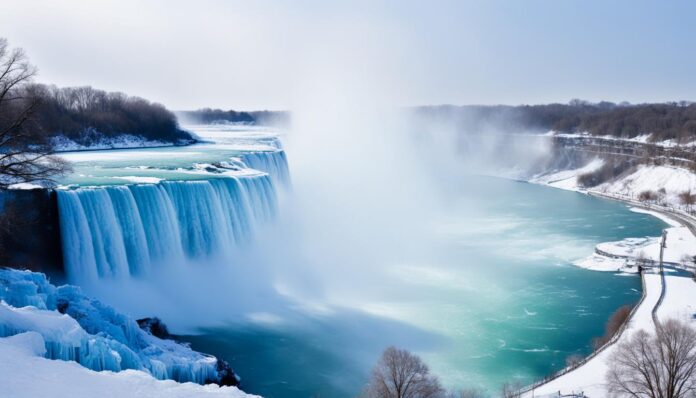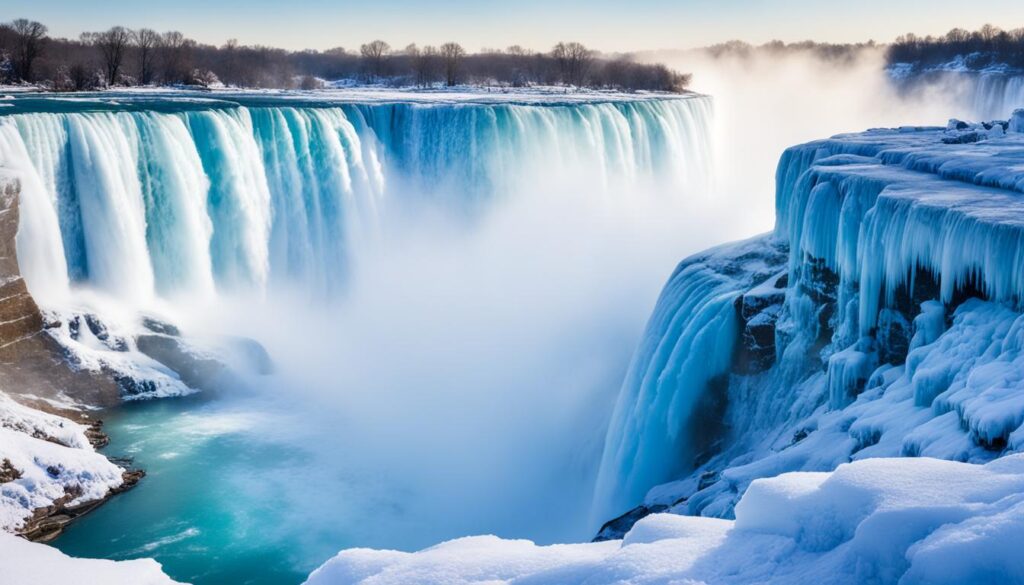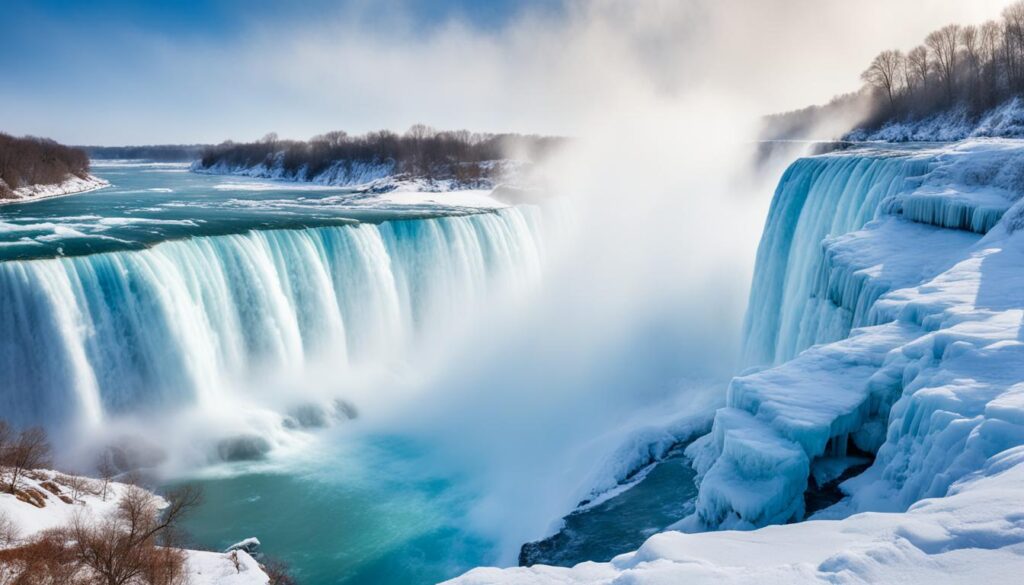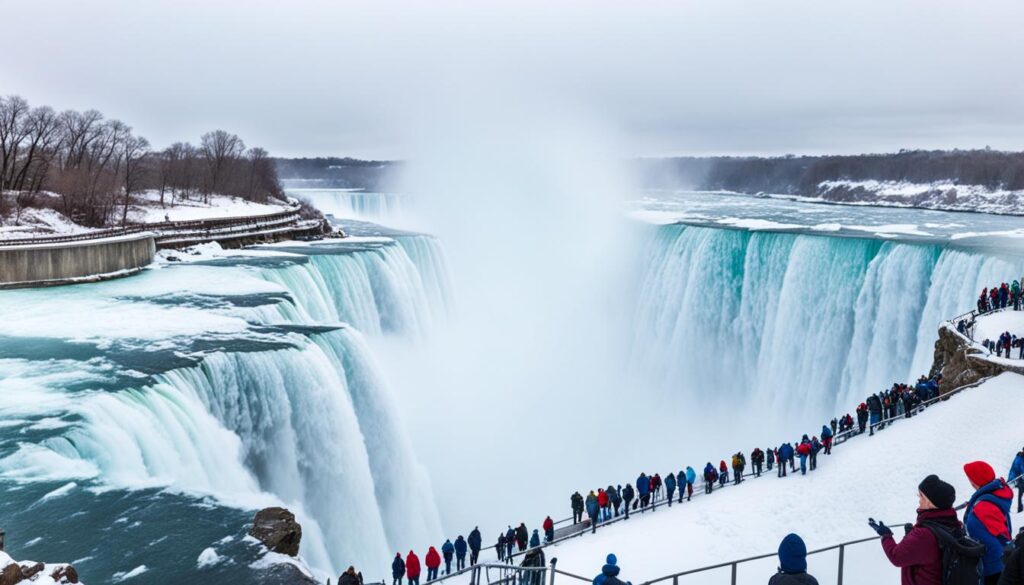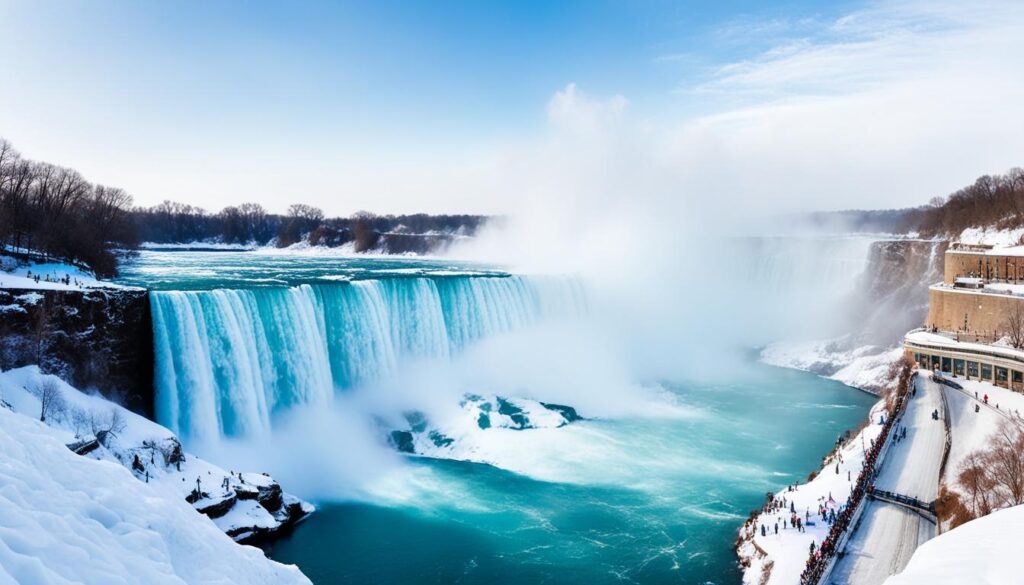When you think of Niagara Falls, images of majestic cascades of water come to mind. But have you ever wondered if this natural wonder freezes over in the winter?
Imagine a frozen landscape, where the rushing waters of Niagara Falls become a frozen spectacle. Is this a reality or just a myth? Let’s unveil the truth behind one of the most intriguing questions: Is Niagara Falls frozen in winter?
Join us as we embark on a journey to unravel the mysteries of Niagara Falls during the winter months. We will delve into the climate and weather conditions, explore the freezing phenomenon, discover historical instances of the falls freezing over, and provide insights on what to expect when visiting this breathtaking natural wonder in winter.
So, grab your winter coats and set out on an adventure with us. Prepare to be amazed by the captivating beauty of Niagara Falls, whether frozen or flowing.
Winter at Niagara Falls: Climate and Weather Conditions
When planning a visit to Niagara Falls during the winter months, it’s important to be prepared for the unique climate and weather conditions that await you. Winter at Niagara Falls is undoubtedly a captivating sight, with the falls enveloped in a stunning icy landscape. In this section, we will explore the climate and weather patterns at Niagara Falls during winter, providing you with valuable insights to help you plan your trip.
Average Temperatures
During winter, Niagara Falls experiences an average temperature range of 25°F (-4°C) to 35°F (2°C). However, it’s important to note that temperatures can often drop below freezing, especially during the peak winter months of January and February. The cold temperatures contribute to the freezing of the falls, creating a breathtaking display of frozen beauty.
Snowfall
Winter at Niagara Falls is synonymous with snowfall, creating a picturesque winter wonderland. On average, the falls receive approximately 80 inches (203 cm) of snow annually, transforming the surrounding landscape into a glistening scene straight out of a postcard. The combination of snowfall and freezing temperatures contributes to the formation of the intricate ice formations that grace the falls and the surrounding areas.
Other Factors
While average temperatures and snowfall are key factors influencing the winter conditions at Niagara Falls, it’s essential to consider other contributing factors as well. The strength and direction of the wind, for example, play a significant role in determining the freezing or non-freezing of the falls. Strong winds can prevent the falls from completely freezing over, allowing the majestic water flow to continue amidst the icy spectacle.
“The freezing temperatures and the heavy snowfall create a mesmerizing spectacle at Niagara Falls, drawing visitors from around the world. Embrace the chill and witness the breathtaking beauty of a frozen natural wonder.”
Winter Climate and Weather Conditions at Niagara Falls
| Average Temperatures | Snowfall | Wind Strength |
|---|---|---|
| 25°F (-4°C) to 35°F (2°C) | Approximately 80 inches (203 cm) | Variable, can impact freezing |
The Freezing Phenomenon: Can Niagara Falls Freeze Over?
One of the most awe-inspiring natural wonders, Niagara Falls, has witnessed numerous wonders over the centuries. One of the intriguing phenomena associated with the falls is the freezing of Niagara Falls during winter. While it may seem unimaginable for such a grand waterfall to freeze, the frigid temperatures and unique conditions make it possible.
Under specific circumstances, typically during prolonged periods of extreme cold, parts of Niagara Falls can freeze, presenting a breathtaking sight. The freezing occurs when the air temperature drops well below freezing point, causing the mist and spray from the falls to freeze and accumulate on the rocks, creating stunning ice formations.
This captivating freeze-over can result in the formation of an extraordinary natural spectacle known as the Niagara Falls ice bridge. The ice bridge forms when the continuous freezing and accumulation of ice build up and form a solid bridge-like structure across the river.
Witnessing the frozen Niagara Falls and the majestic ice bridge is a truly remarkable experience. It showcases the raw power and beauty of nature, captivating visitors from around the world.
However, it is important to note that the freezing of Niagara Falls and the formation of the ice bridge are not an annual occurrence. The conditions must align perfectly for this phenomenon to take place, with extended periods of freezing temperatures and minimal water flow contributing to the formation of ice.
Factors That Contribute to the Freezing of Niagara Falls
Several factors play a crucial role in the freezing of Niagara Falls:
- Temperature: The air temperature must be consistently below freezing point for an extended period.
- Water Flow: To freeze over, the flow of water must be significantly reduced or restricted.
- Mist and Spray: The mist and spray generated by the falls must freeze, accumulating as ice on the rock surfaces.
- Ice Formation: Continuous freezing and accumulation of ice create stunning formations and the potential for an ice bridge.
While the freezing of Niagara Falls is a rare occurrence, when it does happen, it attracts visitors who are eager to witness this extraordinary natural wonder. It is a testament to the power and unpredictability of nature, reminding us of its ability to create wonders even in the harshest of conditions.
| Factors | Likelihood |
|---|---|
| Temperature consistently below freezing point | Rare |
| Significantly reduced water flow | Rare |
| Freezing of mist and spray | Rare |
| Formation of ice and ice bridge | Rare |
Historical Instances of Niagara Falls Freezing
Throughout history, there have been several remarkable instances when the majestic Niagara Falls transformed into a frozen spectacle. These frozen episodes have captivated the imagination of onlookers and served as a testament to nature’s extraordinary power and beauty.
One notable event occurred in the winter of 1848-1849, when the falls partially froze due to an exceptionally cold season. The frigid temperatures caused a significant amount of ice to form at the base of the falls, creating a stunning ice bridge that spanned the Niagara River.
“The sight was truly magnificent. The noise, even at a distance, is deafening, resounding through the air like the discharge of heavy artillery.” – Matthew Dixon, 19th-century explorer
This extraordinary spectacle attracted visitors from near and far who marveled at the frozen wonderland. Some daring individuals even ventured onto the ice bridge, braving the elements for a chance to witness this natural phenomenon up close.
Another significant occasion occurred in 1912 during a particularly harsh winter. The falls were covered in a thick layer of ice, and the weight of the frozen water created immense pressure, causing sections of the ice to crack and tumble downstream.
Over the years, these historical events have solidified Niagara Falls’ reputation as a natural wonder that can transform into a breathtaking ice sculpture during the coldest months of the year.
Exploring Frozen Niagara Falls: A Glimpse into History
Let’s take a closer look at two of the most remarkable instances of Niagara Falls freezing:
| Year | Description |
|---|---|
| 1848-1849 | Severe winter freezes part of the falls, creating an incredible ice bridge across the Niagara River. |
| 1912 | Harsh winter results in a thick layer of ice covering the falls, leading to dramatic ice cracking and movement. |
These historical accounts provide a glimpse into the awe-inspiring moments when Niagara Falls defies its flowing nature and transforms into an icy wonderland.
Visiting Niagara Falls in Winter: What to Expect
Planning a visit to Niagara Falls during the winter months? You’re in for a truly unforgettable experience. While the falls may be partially frozen, the beauty and majesty of this natural wonder remain awe-inspiring. Here’s what you can expect when visiting Niagara Falls in winter:
Breathtaking Views
Prepare to be amazed by the picturesque winter landscapes surrounding Niagara Falls. The glistening ice formations and snow-covered scenery create a surreal atmosphere. As you stand near the falls, you’ll witness the powerful rush of water cascading down the frozen cliffs, creating a spectacle that will leave you in awe.
Unique Winter Activities
Winter at Niagara Falls also brings a host of unique activities that are sure to enhance your visit. Lace up your ice skates and glide on the outdoor rink overlooking the falls, or embark on an exhilarating winter hike along the trails surrounding the area. For an unforgettable experience, consider taking a helicopter tour to view the frozen falls from above.
| Winter Activities at Niagara Falls | Details |
|---|---|
| Snowshoeing | Explore the beautiful winter landscapes on guided snowshoeing tours. |
| Ice Climbing | Challenge yourself with ice climbing adventures on frozen waterfalls. |
| Winter Festivals | Join in the lively winter festivals and celebrations that take place near the falls. |
Less Crowded
Visiting Niagara Falls in winter offers the advantage of smaller crowds compared to the peak tourist seasons. You’ll have more space to explore, take photographs, and fully immerse yourself in the beauty of the falls. It’s the perfect opportunity to enjoy a more intimate experience with nature.
“Niagara Falls in winter is a magical sight. The frozen landscape creates a serene and peaceful atmosphere that allows visitors to truly appreciate the grandeur of nature.” – Lisa Johnson, Winter Travel Enthusiast
Weather Considerations
It’s important to keep in mind that winter weather can be harsh at Niagara Falls. Dress warmly with layers and don’t forget to wear sturdy footwear suitable for icy conditions. It’s also advisable to check the weather forecast and plan your visit accordingly to make the most of your time there.
Embrace the enchantment of Niagara Falls in winter and create unforgettable memories. Experience the awe-inspiring beauty, engage in exciting winter activities, and bask in the serenity that this season brings to the falls.
Safety Precautions and Tips for Winter Visits
Safety is of utmost importance when visiting Niagara Falls during the winter. The freezing temperatures and icy conditions can present unique challenges, but with the right precautions, you can have a safe and enjoyable experience. Here are some essential tips to keep in mind:
Dress Appropriately
When exploring Niagara Falls in winter, it’s crucial to dress warmly and layer your clothing. The frigid temperatures combined with the mist from the falls can make the air extremely cold. Wear thermal or woolen layers, a waterproof outer layer, a hat, gloves, and insulated boots to protect yourself from the cold.
Stay on Designated Pathways
Stick to the designated pathways and viewpoints when visiting Niagara Falls in winter. These areas are regularly maintained and cleared of ice and snow, reducing the risk of slips and falls. Avoid venturing onto frozen bodies of water or unfamiliar paths, as they may not be safe or stable.
Be Cautious of Slippery Surfaces
The frozen conditions make surfaces around the falls extremely slippery. Exercise caution when walking and avoid rushing or running, especially near the edge of the falls. Walk slowly and deliberately, using handrails and holding onto barriers for extra stability.
Observe Safety Signage
Pay attention to safety signage and warnings posted throughout the area. These signs provide important information and guidelines for visitors. Follow any instructions given by park authorities or staff members to ensure your safety and the safety of those around you.
Stay Hydrated and Nourished
Despite the cold temperatures, it’s essential to stay hydrated and nourished during your visit. Drink plenty of fluids and consume nutritious snacks to maintain energy levels and prevent dehydration. Consider carrying a refillable water bottle and packing some high-energy snacks for the trip.
Keep an Eye on the Weather
Check the weather conditions and forecasts before your visit to Niagara Falls in winter. Extreme weather events, such as heavy snowfall or freezing rain, can impact the safety and accessibility of the area. Plan your visit accordingly and be prepared to reschedule if necessary.
“Safety should always be the top priority when visiting Niagara Falls in winter. By dressing appropriately, staying on designated pathways, being cautious of slippery surfaces, observing safety signage, staying hydrated and nourished, and keeping an eye on the weather, you can have a safe and memorable experience at this natural wonder.” – Niagara Falls Park Authorities
Remember, while Niagara Falls is a breathtaking sight to behold in winter, caution and common sense are key to ensuring a safe visit. By following these tips and prioritizing your safety, you can fully enjoy the beauty and wonder of Niagara Falls during the winter season.
| Tips for Safety Precautions at Niagara Falls in Winter |
|---|
| Dress warmly and layer your clothing. |
| Stay on designated pathways and viewpoints. |
| Be cautious of slippery surfaces. |
| Observe safety signage. |
| Stay hydrated and nourished. |
| Keep an eye on the weather. |
Capturing the Beauty: Photography Tips for Winter Visits
Niagara Falls in winter transforms into a picturesque wonderland, offering breathtaking views and awe-inspiring scenery. For photography enthusiasts, this is a perfect opportunity to capture the mesmerizing beauty of the frozen falls. Here are some useful tips and techniques to elevate your photography skills during your winter visit to Niagara Falls.
1. Dress for the Weather
Before you embark on your photography adventure, make sure to dress appropriately for the winter weather conditions. Layer your clothing to stay warm and comfortable, and don’t forget to wear gloves to protect your hands while handling the camera.
2. Find the Perfect Spot
Scout the area near the falls to find the best vantage points for capturing the frozen beauty. Consider viewpoints that provide unique perspectives and showcase the grandeur of the frozen falls. Experiment with different angles and compositions to create visually striking images.
3. Capture the Details
While the overall view of the frozen falls is stunning, don’t forget to focus on capturing the intricate details. Zoom in on the ice formations, icicles, and delicate patterns to capture the essence of the frozen landscape up close.
4. Utilize Natural Lighting
The soft, diffused light in winter can create a magical atmosphere in your photographs. Take advantage of the golden hour, just after sunrise or before sunset, when the light casts a warm glow over the frozen falls. Experiment with different lighting conditions throughout the day to capture unique and evocative images.
5. Long Exposure Techniques
Consider using long exposure techniques to add a sense of motion and dynamism to your winter photographs. Experiment with slower shutter speeds to create silky smooth water effects or capture the movement of falling snowflakes.
6. Protect Your Equipment
Winter conditions can be harsh, so it’s crucial to protect your camera gear from the cold and moisture. Use a dry cloth to wipe your equipment regularly, and consider using a rain cover or plastic bag to shield it from snow or rain. Keep spare batteries in a warm pocket to extend their life in cold temperatures.
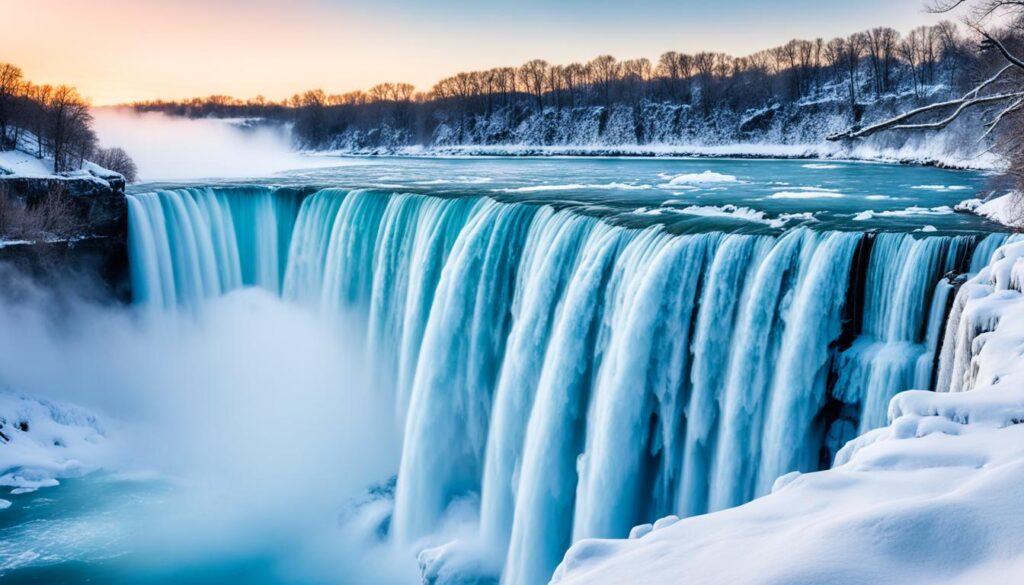
7. Experiment with Editing
After capturing your winter photographs, unleash your creativity during the editing process. Enhance the colors, adjust the exposure, and bring out the details to create stunning visuals that reflect the beauty of Niagara Falls in winter.
By following these tips and techniques, you can capture awe-inspiring images that showcase the frozen beauty of Niagara Falls during the winter months. Remember to immerse yourself in the experience and let your photography tell the story of the captivating winter wonderland that is Niagara Falls.
Winter Activities at Niagara Falls
When visiting Niagara Falls in winter, there’s no shortage of exciting activities to keep you entertained and make your trip unforgettable. From thrilling adventures to serene experiences, the winter wonderland offers something for everyone. Here are some of the top winter activities at Niagara Falls:
1. Ice Climbing
Challenge your adventurous spirit by trying ice climbing at Niagara Falls. With its frozen walls and unique formations, the falls provide a thrilling backdrop for this exhilarating activity. Whether you’re a seasoned climber or a beginner, there are options available for all skill levels.
2. Snowshoeing
Explore the stunning winter landscape surrounding Niagara Falls on a snowshoeing adventure. Strap on your snowshoes and venture into the snowy trails, immersing yourself in the peaceful ambiance of the winter wilderness. It’s a great way to appreciate the natural beauty of the area.
3. Winter Festivals
Experience the vibrant atmosphere of winter festivals held near Niagara Falls. These events offer a variety of entertainment, from live music performances to ice carving competitions. Embrace the festive spirit, indulge in local cuisine, and enjoy the lively atmosphere with family and friends.
4. Winter Hiking
Put on your warmest clothing and embark on a scenic winter hike around the falls. Traverse through snow-covered trails, witness breathtaking views, and capture beautiful photographs of the frozen landscape. Just be sure to dress appropriately and stay on designated paths for safety.
5. Skating
Lace up your ice skates and glide across the frozen surfaces near Niagara Falls. Several outdoor ice rinks offer a perfect setting for ice skating, creating a magical experience surrounded by the stunning winter scenery. Whether you’re a beginner or a seasoned skater, it’s a fun activity for all ages.
6. Winter Boat Tours
Experience the falls from a different perspective by embarking on a winter boat tour. Wrap yourself in warm blankets and cruise along the icy waters, marveling at the frozen splendor of Niagara Falls. It’s a unique opportunity to witness the falls’ grandeur up close.
These are just a few examples of the myriad of winter activities you can enjoy at Niagara Falls. Embrace the magic of the season and create unforgettable memories in this enchanting winter wonderland.
Conclusion
After carefully examining the phenomenon of Niagara Falls during the winter months, we can conclude that while the falls may partially freeze, they rarely freeze completely. The relentless force of the water and the constant flow prevent a complete freeze, creating a dynamic and ever-changing spectacle.
Visiting Niagara Falls in winter offers a unique and awe-inspiring experience. The contrast between the freezing temperatures and the rushing water creates a mesmerizing sight. The mist from the falls coats nearby trees and rocks, turning them into glistening ice sculptures that add to the magical ambiance.
While the falls may not be fully frozen, the winter months offer other delights such as dramatic ice formations and the occasional ice bridge. These natural wonders provide stunning photo opportunities and unforgettable memories.




























